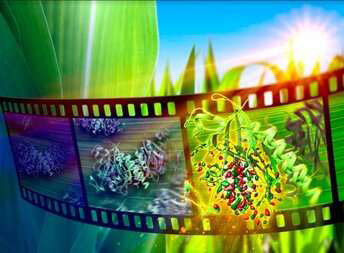
Scientists have revealed intricate structural changes in plants, fungi and bacteria in response to light, according to a new study published today in the open-access journal eLife.
The findings provide new insights into the function of protein molecules called phytochromes that are present in these three types of organisms. The results could lead to tools that control the function of phytochromes to achieve more efficient growth patterns in plants and crops.
Plants constantly adapt to changes in light and control their growth patterns according to light availability. They achieve this through phytochromes, the origin of light detection in all vegetation on Earth. Phytochromes can adopt two different shapes depending on the light available. To achieve this change in shape, a cascade of signals occurs starting at the chromophore—the point within the phytochrome where light is absorbed.
"The phytochrome allows organisms to distinguish between two colours of light, giving plants, fungi and bacteria primitive two-colour vision," explains lead author Elin Claesson, a doctoral student at the University of Gothenburg, Sweden. "Key to its function is the initial response to light, where the light signal is translated into structural changes over a fraction of a second. The mechanisms that allow this translation are poorly understood, because the technology for studying phytochromes immediately after light reaches them has not previously been available."
To address this gap, the team led by Sebastian Westenhoff, Professor at the Department of Chemistry & Molecular Biology, University of Gothenburg, and Marius Schmidt, Professor at the Physics Department, University of Wisconsin-Milwaukee, US, used a novel X-ray laser that can capture pictures of proteins at an atomic level every 10 femtoseconds (a quadrillionth of a second). This enabled them to reveal the movement of each atomic component of the phytochrome protein and piece together the cascade of events that triggers growth in response to light.
The team found surprisingly large rearrangements of the chromophore and its surrounding protein structures immediately after light absorption. They observed the twisting of part of the chromophore called the D-ring, which in turn causes displacement of the neighbouring rings as well as changes of atoms around the chromophore. Surprisingly, they also discovered the release of a water molecule, called pyrrole water, that is found in the same place in phytochromes across all organisms.
"These findings demonstrate that the initial response to light is highly collective and that many parts of the chromophore and phytochrome protein play an important role," concludes senior author Sebastian Westenhoff. "Our study confirms a previous working model of the twisting motion of the D-ring and suggests that the pyrrole water molecule is also important in this process. We propose that both chemical events work together enabling phytochrome proteins to translate light into structural signals, guiding the growth and development of plants, fungi and bacteria on Earth."

